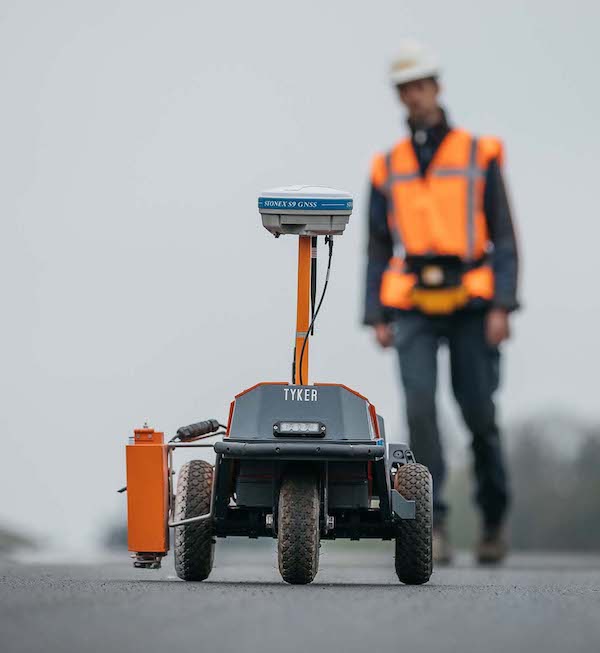The Robot Plotter is a compact, fully autonomous, self-driving robot that uses RTK-GNSS positioning to place lines and other markings on a variety of ground surfaces. The machine, made by Netherlands-based Tyker Automation, sets out markings 12 to 16 times faster than traditional three- or four-person crews.
“The Robot Plotter is highly accurate in the way it places lines on the ground,” said Tyker International Sales Manager Arno Tammerijn, speaking at InterGEO 2022 in Essen. “We know there are other line drawing robots out there, doing a similar job, but for me, one of the things that makes us different from the competitors is our build, the way our machine is constructed. The Robot Plotter is tough, a very solid workhorse. It’s made for hard work. It can do both road and off-highway applications. That means also things like pre-marking on construction sites and building projects, using the positioning technology to place very accurate marks on the ground.”
The Robot Plotter integrates Stonex GNSS integrated receivers, with the latest, high-accuracy multi-constellation antennas, tracking all operational GNSS constellations – GPS, Glonass, Beidou and Galileo. A fully integrated UHF transmitter and GSM 3G modem complete the Robot Plotter communications solution. The Stonex S9iintegrated GPS receiver also features easy-to-upgrade firmware. Robot Plotter can also be controlled by a conventional total station.
usine
Tyker was founded in 2008 as a Wageningen University-based spin-off. Today the company specializes in robotics for off-highway mobile machines encompassing concept development, modelling, simulation, sensor fusion, motion planning and control.
“We are really focused on automation of work processes,” Tammerijn said, “with our strength in road construction, using robotics, localization and control. We like to say we are increasing the pleasure of working while reducing the workload. Of course the Robot Plotter provides enormous cost savings, when you consider we are gaining time and reducing the need for human operators. This is a hard and tedious job for human crews, and there are dangers associated with working on highways and on construction sites, which we can completely eliminate with Robot Plotter. It is very easy to transport and set up this machine. The interface is very simple. You upload the pre-programmed mission and it goes to work.”
Detailed drawings of lines to be marked can be transferred to the Robot Plotter via the Tyker Civil web application, or via a USB stick. Operators can also use Tyker Civil to track the machine’s location and follow mission progress in real time.
Tammerijn said Tyker is doing good business, with a growing set of international clients. “This is a growing market,” he said. “Automation, autonomy and robotics, you see it now everywhere and it’s just getting bigger. And there are so many more applications that we can imagine, combining robust and reliable robotics with accurate positioning, the latest RTK and GNSS technologies. We are not going away.”






